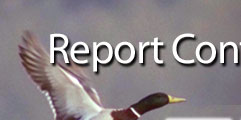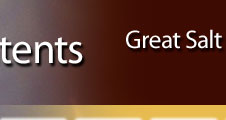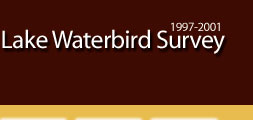|
Great Salt Lake Waterbird Survey
Five-Year Report (1997-2001)
Preface
The Great Salt Lake Ecosystem Program was instituted by the Utah Division of Wildlife Resources (UDWR) in July of 1996. Our goal was to study Great Salt Lake (GSL) and its biota. An important part of this objective was understanding the biology of brine shrimp and how it relates to three important questions. How many brine shrimp cysts should remain in the lake after their commercial, fall harvest in order to sustain shrimp populations the following spring? What are the food needs of the birds? What is the remaining cyst availability for the subsequent harvest?
We determined that for a survey of the birds associated with the lake, it would be necessary to quantify what species utilized the lake, how many, and where they occurred throughout the year. Habitat conditions were also of interest. As the levels of the lake fluctuate, so do the habitats and bird use. A five year study helped to account for this critical influence along with normal bird population fluctuations. For that period of time, over 150 personnel, many of them volunteers, conducted surveys of up to 51 sites 17 times per year. The five year survey resulted in an enormous data set.
After the five years of surveys, two years were spent assembling, analyzing, editing, and presenting the data. After preparing a preliminary report, we decided color graphics best represented the data, however, the size of the report (313 pages) made comparisons between species, sites, and times of the year cumbersome. We discovered a similar representation of data done by the Oregon Department of Fish and Wildlife in an interactive CD. That format presented the data and allowed comparisons much better than the written report and permitted an easier and more cost effective method to distribute and share the information. At that time, the popularity of the internet was growing quickly, and we saw the opportunity for presenting the information on the UDWR website as well on CD.
A tremendous amount of work was done by UDWR staff and Matt Cole to construct the interactive CD. The result of all these efforts culminated in the end product you are viewing now. We believe this presentation of the data is in a form that is most user friendly and easy to understand. Studying bird use at the lake for five years gave us tremendous resolution on what species, and their populations, use specific places around the lake over time. With this information, biologists are able to offer the best advice about habitat conservation and continue monitoring populations in an effort to realize our goal of understanding GSL biota.
We gratefully acknowledge the help and assistance that many offered to achieve this goal. First and foremost, we recognize all of those that trudged through mud, bugs, and salt for many survey periods over the five years of the project. Matt Cole worked for a long time to develop the CD and suffered through many edits and changes until we had the best possible product. Suzanne Fellows, of the U. S. Fish and Wildlife Service, provided funding to cover a portion of the costs to develop the CD. Jon Bart, of the USGS Snake River Field Station, provided technical interpretation of the data. All of the Great Salt Lake Ecosystem Program staff over the years have developed and contributed, especially Don Paul, Ann Manning, John Luft, John Neill, and Clay Perschon. With an effort this size, there are undoubtedly others that lent a hand. To all of you, a very sincere thank you. Your efforts have resulted in the conclusive success of the project.
--Clay Perschon, Fmr. Great Salt Lake Ecosystem Program Manager
|










